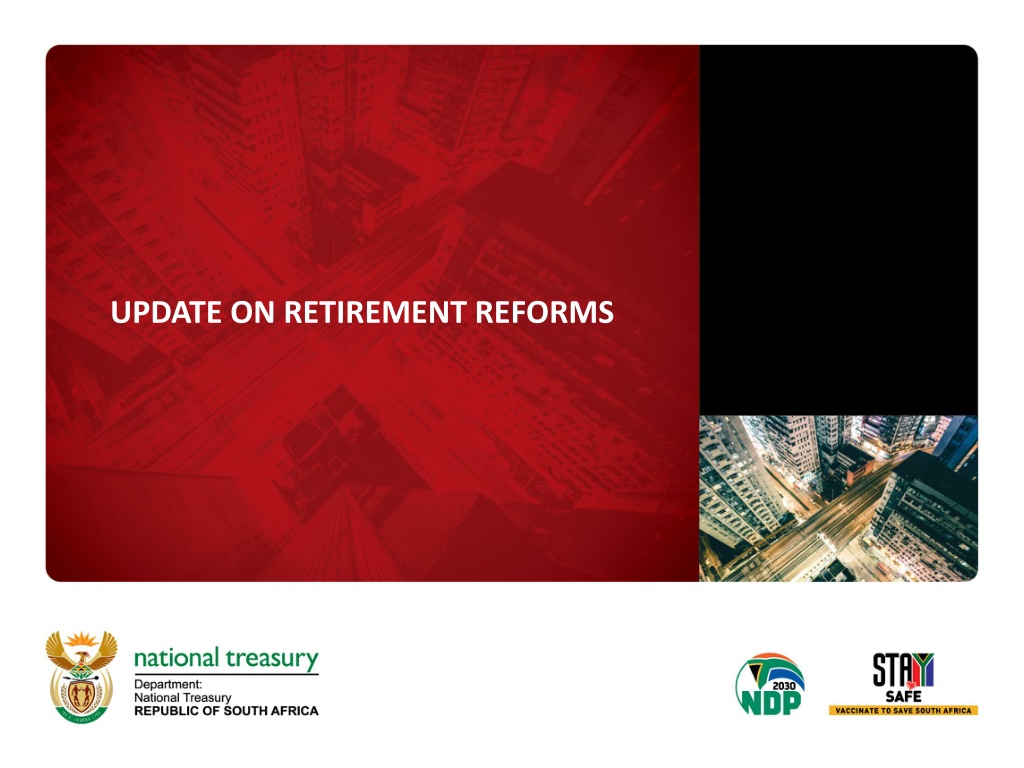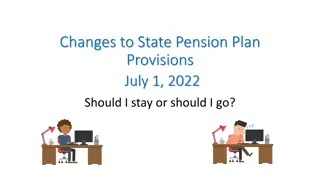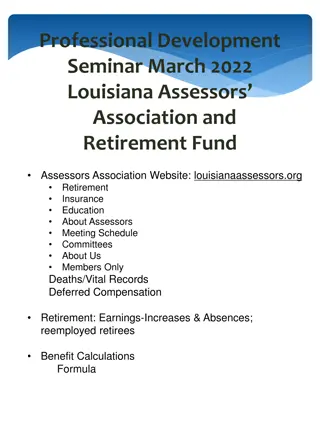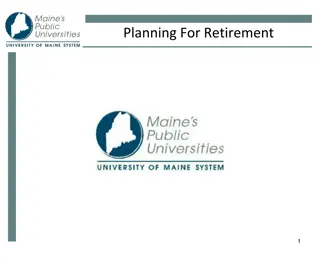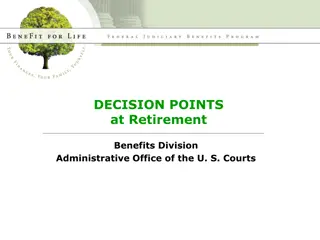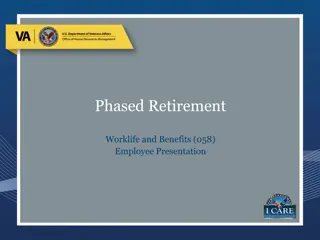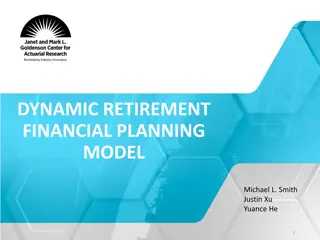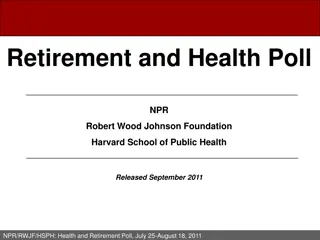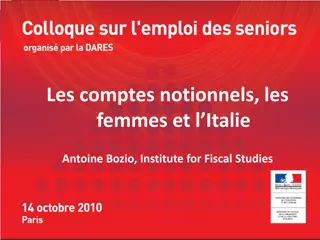Update on Retirement Reforms in South Africa
South Africa has been implementing retirement reforms focusing on enhancing governance, extending coverage, encouraging preservation, and simplifying taxation since 2012. The latest phase includes a two-pot system, auto-enrolment, and efforts to address challenges like inadequate benefits and poor fund governance. The post-Covid-19 reform journey aims at sustainable finance, extending coverage to the informal sector, and ensuring traditional pension saving is suitable for all workers.
Download Presentation

Please find below an Image/Link to download the presentation.
The content on the website is provided AS IS for your information and personal use only. It may not be sold, licensed, or shared on other websites without obtaining consent from the author. Download presentation by click this link. If you encounter any issues during the download, it is possible that the publisher has removed the file from their server.
E N D
Presentation Transcript
2 Topics a) Background b) Progress to date c) Reforms in progress Two-pot system Extended coverage of retirement system Auto-enrolment Informal sector coverage Governance & Consolidation of RFs Review of the annuities market Comprehensive Social Security CoFI Bill
3 Background SA has a well-developed retirement savings industry and sound regulatory system Despite this, we still have some challenges with Inadequate level of benefits (poor coverage) Certain opaque costs Poor fund governance (integrity concerns) Large number of funds The first phase of reforms, between 2012 and 2019 focused on Encouraging preservation Enhancing governance of funds Encouraging annuitisation at the time of retirement Simplifying the taxation of retirement contributions Encouraging non-retirement saving through tax free saving plans Encouraging good value retirement products and services by reviewing cost Retirement reform is long term and not an easy process Requires strong political will and support from labour unions and industry, and buy-in from members of retirement funds
4 Progress on retirement reforms since 2012 Pre-retirement preservation Default preservation regulation in place since March 2019 Enhanced governance of funds Criminal and personal liability to employers in respect of non-payment of retirement contributions to a retirement fund Skills training for trustees through trustee toolkit Annuitisation at the time of retirement Provident fund annuitisation requirement effective as of March 2021 Simplification of the taxation of retirement contributions Tax deduction same across all funds since March 2016 Non-retirement saving through tax-free saving plans Tax-Free Savings Accounts since April 2015 Having good value retirement products and services Regulations on default investment portfolio and annuity strategy since March 2019
5 Post-Covid-19 reform journey The emergence of Covid-19 has raised various issues Sustainable finance Funding for infrastructure Early access to retirement savings for emergencies Extending coverage to those in the formal sector without retirement plans Some form of saving for those in the informal sector Pertinent question whether traditional pension saving is suitable for low-income and informal workers And what do we mean by informal workers The proposed Two-Pot system is meant to deal with dilemma of lack of preservation before retirement (pre-retirement leakage) lack of access even in cases of emergency by some households that are in financial distress and have assets within retirement funds
6 Policy proposals The two-pot system Two new pots created a savings pot" and a retirement pot" Changes affect all funds (will also apply to public sector funds) Each member can contribute up to 1/3rd of their contributions to the savings pot, with the remainder going to the retirement pot It is proposed that the savings pot starts with seeding capital transferred from the vested pot Tax deduction on contributions continues to apply Vested pot pre-1 March 2024 balances No further contributions into this pot for pension funds or retirement annuity funds or provident funds, except provident fund members who were over the age of 55 on 1 March 2021 can continue to contribute to that provident fund Treated in terms of current rules for transfers, resignation and retirement First phase of legislative amendments to the retirement system is due to take effect on 1 March 2024 A second draft of the legislation will be released for public comments, envisaged to be before the normal TLAB amendments PFA amendments related to the two-pot system envisaged to be released for public comment soon after the RLAB
7 Policy proposals Individuals may withdraw any amount from the savings pot, which is not subject to any conditions Withdrawals before retirement will be taxed at marginal rates One withdrawal in any 12-month period Minimum amount R2,000 No withdrawals from the retirement pot before retirement If a member changes funds, all pots should be transferred to the new fund, and mirror the transferor structure Legacy retirement annuity funds Consideration of an exemption for legacy RAs not able to implement two-pot system for some of their members Different strategy being considered for DB funds Reduction of period of service Fund chosen methodology verified and acceptable to the FSCA
8 Policy proposals Resignation Vested Pot fully accessible as a cash lump sum or can be transferred Savings Pot member continues with annual withdrawals or can be transferred Retirement Pot preserved till retirement Retrenchment Access to Vested Pot in terms of current rules Withdrawals from Savings Pot continue subject to tax Retirement Pot gets preserved till retirement Retirement Vested Pot annuitised subject to current rules and de minimis threshold Savings Pot accessible as cash lump sum if there s any balance left subj to tax Retirement Pot subject to annuitisation requirement in terms of the de minimis threshold
9 Governance & consolidation Concern with the effective supervision of a large number of funds 32% per cent of funds have less than 100 members, which adds considerably to the regulatory workload With about 68% of active funds having less than 1000 members (FSCA data) Policy proposal is fund consolidation to a manageable number Cannot encourage consolidation into umbrella funds till governance issues are resolved Questions wrt umbrella funds Possibility of member representation on Boards of Trustees in umbrella funds Over-dependence of board members on product and service providers for advice Conflicts between loyalty to members and to those who elected or appointed the board members Locking-in of umbrella funds to services provided solely by the sponsor Barriers to switching service from one umbrella fund to another
10 Possible Solutions View is that implementation of the two-pot system will facilitate/encourage further consolidation? Barriers to consolidation Tax directive Section 14 transfers Member representation on boards of umbrella funds Comments found this neither practical, appropriate nor cost effective Formalisation of Mancos or advisory committees Mechanism to enforce transparency and disclosure of costs Adopt retirement savings cost disclosure or similar standard No-lock in provisions should be allowed in agreements with providers Resolving impediments to termination of a sponsor or employer participation
11 Extending coverage of retirement funds Contribution to a retirement fund is not mandatory in SA 2022 Q3 Labour Force Survey estimates that around 13 million individuals are employed Of these 5.8 million are not contributing 6.8 million are contributing to a retirement fund 388 000 did not know if they were Covering informal sector poses a challenge for many systems globally Retirement savings built around salaried/wage-based employees formally employed who can make regular and fixed contributions South Africa s consideration of the establishment of a mandatory national retirement fund Mandatory arrangements focus more on the needs of workers with jobs in the formal economy With auto-enrolment working well for formal salaried employees with the presence of an employer Proposal Introduce auto-enrolment in respect of formally employed workers not contributing Next step would be extending coverage to informal or vulnerable sector Through a more voluntary system backed by some form of incentives, FinTech and a default fund
12 THANK YOU
